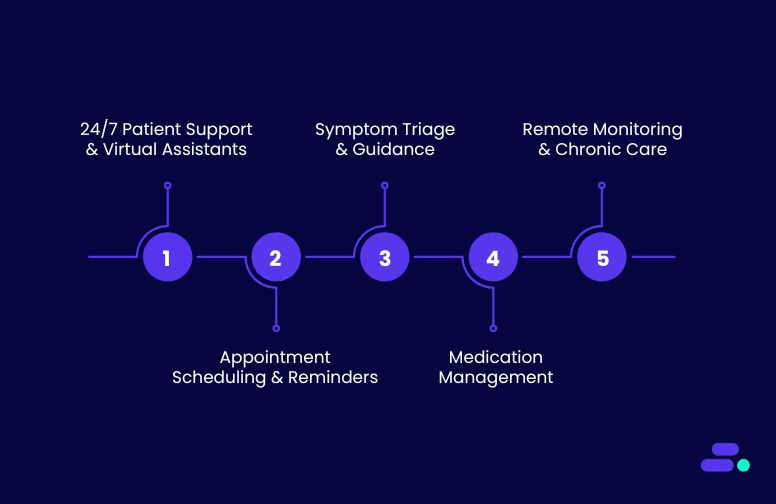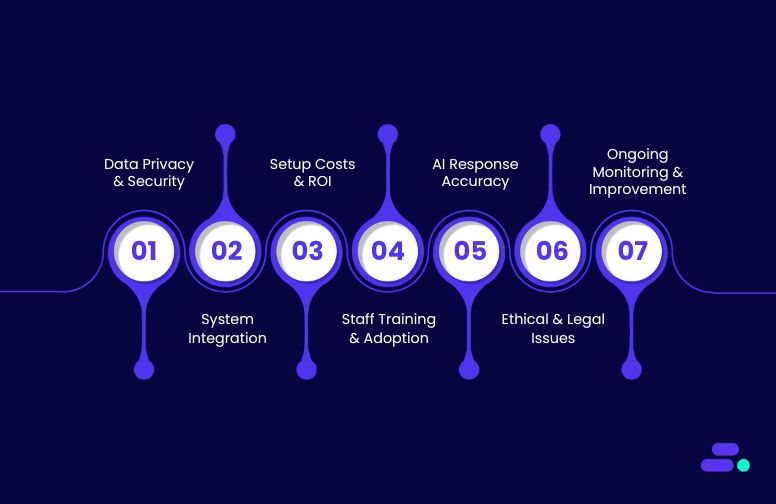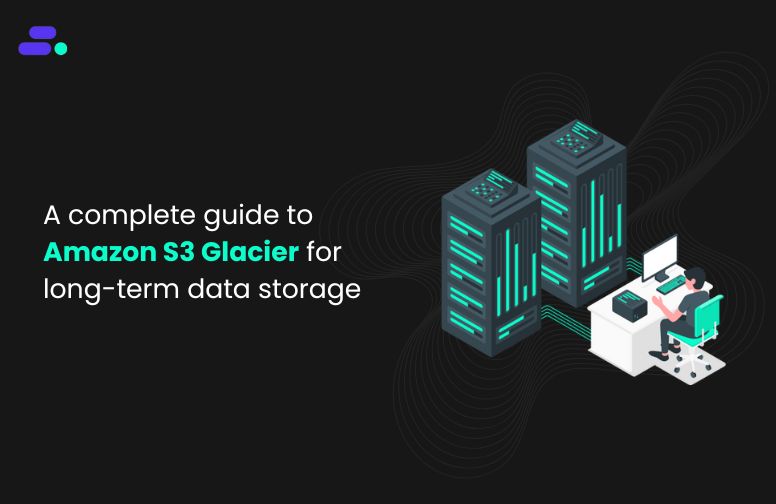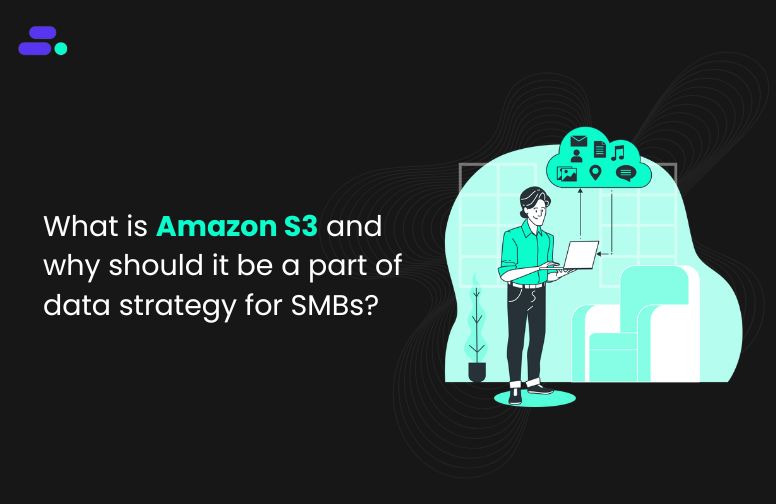This is a div block with a Webflow interaction that will be triggered when the heading is in the view.

Modernize your cloud. Maximize business impact.
Small and mid-sized businesses (SMBs) that adopt cloud technologies early grow significantly faster than those that don’t. A study cited by Inc.com found that tech-forward SMBs (all using cloud) grew at a 13% CAGR, compared to just 3% for those who didn’t.
The reason? Cloud migration eliminates large upfront IT costs and unlocks pay-as-you-go flexibility that accelerates growth.
For example, instead of investing in expensive, on-prem CRM software, a growing services firm can adopt a cloud-based CRM like Amazon Connect. They pay only for active usage, scale instantly as new clients join, and integrate customer data across teams in real time. That efficiency frees up capital and time, resources that can be redirected into customer acquisition, new hires, or product innovation.
This article explores why cloud migration is a growth catalyst for small businesses and outlines practical strategies to maximize ROI, agility, and long-term value.
Key takeaways:
- Cloud migration replaces costly upfront IT investments with flexible, pay-as-you-go infrastructure, helping SMBs scale without overcommitting capital.
- Speed and agility improve dramatically as cloud services enable faster development, deployment, and innovation, reducing time to market from months to days.
- Elastic scalability and built-in resilience ensure SMBs can handle demand spikes, maintain uptime, and recover from disruptions without manual effort.
- Access to enterprise-grade technologies like AI, analytics, and automation becomes affordable and manageable, giving SMBs a competitive edge.
- Cloudtech helps SMBs unlock real growth from migration by delivering modern, cost-optimized architectures with hands-on support, training, and measurable outcomes.
10 reasons why cloud migration is critical for SMBs seeking growth
Traditional infrastructure often demands time, capital, and specialized talent to maintain. For lean teams, this creates an operational burden that pulls focus away from innovation, customer experience, and go-to-market speed.
By migrating to the cloud, SMBs offload infrastructure management to providers like AWS, enabling them to redirect internal resources toward high-impact work like launching products, expanding into new markets, or automating internal operations. Modern cloud services like AWS offer built-in scalability, high availability, security, and observability, capabilities once reserved for large enterprises.
This shift empowers SMBs to operate with agility, adopt new technologies quickly, and compete with larger players without being weighed down by legacy constraints. This is one of the many reasons why migrating to the cloud is a smart, growth-focused move for SMBs:
1. Lower upfront costs
For many SMBs, capital constraints are a major barrier to scaling. Traditional IT demands significant upfront investment in servers, storage, and licenses. These are costs incurred before delivering real value. Cloud migration shifts this model by converting capital expenses (CapEx) into operational expenses (OpEx), enabling pay-as-you-go flexibility. This aligns costs with actual usage, allowing businesses to grow without overcommitting financially.
How SMBs reduce upfront costs with the cloud:
- No physical infrastructure needed: Services like Amazon EC2 and S3 replace on-prem hardware with usage-based cloud resources, no servers or data center space required.
- Lower software and support costs: Managed services like RDS and Lambda eliminate licensing fees, reduce maintenance, and minimize IT staffing needs.
- Elastic scaling, no overprovisioning: Tools like Auto Scaling and Aurora adjust resources automatically based on real-time demand, no more capacity guesswork.
Use case: A regional logistics SMB spends over $15,000 annually on on-prem servers, backup hardware, and software licenses for its shipment tracking platform. IT teams are often tied up managing downtime, patches, and hardware upgrades. After migrating to AWS, using Amazon EC2, RDS, S3, and CloudWatch, the company reduces infrastructure costs by over 65% and shifts to predictable, usage-based billing. The savings are reinvested in digital marketing and route optimization R&D, driving a 40% increase in order volume within 12 months.
2. Faster time to market
For growing SMBs, speed is often the biggest competitive advantage. Traditional infrastructure slows down innovation with long procurement cycles, manual setup, and deployment delays. Cloud migration eliminates these blockers by providing instant access to scalable infrastructure and fully managed services. This enables teams to build, test, and launch applications or features quickly, within days instead of months.
How SMBs accelerate time to market with the cloud:
- Instant provisioning of resources: Services like Amazon EC2, AWS Lambda, and Fargate allow developers to spin up compute environments in minutes, with no hardware setup or manual provisioning needed.
- CI/CD automation: Tools such as AWS CodePipeline and CodeDeploy streamline build, test, and deployment pipelines, helping teams ship faster with fewer errors.
- Integrated developer tooling: Services like AWS Amplify and API Gateway simplify backend setup and API management, reducing dev time and complexity.
Use case: A SaaS SMB building a customer support platform struggles to launch new features due to hardware delays and manual deployment processes. After migrating to AWS, the team adopts AWS Lambda for backend logic, Amazon API Gateway for endpoint management, and AWS CodePipeline for automated deployments. New features now roll out in days, not weeks. As a result, the business accelerates its release cycles, rapidly responds to customer feedback, and increases user retention by 25% in under six months.
3. Scalability on demand
For small and mid-sized businesses, unpredictable traffic patterns and seasonal surges can overwhelm fixed infrastructure. Traditional systems force teams to either overprovision (wasting money) or underprepare (risking downtime). Cloud migration solves this by enabling elastic scalability, automatically adjusting resources in real time to match actual demand.
How SMBs scale efficiently with the cloud:
- Elastic compute and storage: Services like Amazon EC2 Auto Scaling and Amazon S3 automatically adjust capacity based on usage, ensuring consistent performance without manual intervention.
- Database scalability: Amazon Aurora and DynamoDB support dynamic scaling, accommodating traffic spikes without performance degradation.
- Load balancing and distribution: Amazon Elastic Load Balancing distributes traffic across resources for high availability during peak times.
Use case: A D2C apparel SMB experiences large traffic spikes during festive sales and influencer-driven campaigns. Previously, their on-prem setup struggled with sudden demand, resulting in slowdowns and missed sales. After migrating to AWS, the business uses Amazon EC2 Auto Scaling, Amazon Aurora, and Elastic Load Balancing. The platform now scales up automatically during peak loads and scales down when traffic drops, reducing costs and improving customer experience. The SMB can now handle 4x normal traffic without downtime, increasing conversion rates by 30%.

4. Better business continuity
Downtime can be devastating for SMBs, causing lost revenue, damaged customer trust, and operational setbacks. Traditional disaster recovery setups often require separate hardware, complex failover systems, and high costs. Cloud migration dramatically improves business continuity by making backup, recovery, and redundancy built-in and easier to manage.
How SMBs strengthen resilience with the cloud:
- Automated backups and point-in-time recovery: Services like Amazon RDS and Amazon DynamoDB offer built-in backup and restore features with minimal configuration.
- Multi-AZ and multi-region architecture: Tools like Amazon S3 and Amazon EC2 support replication across availability zones or regions to maintain uptime even during localized failures.
- Disaster recovery planning made easy: AWS Backup and AWS Elastic Disaster Recovery simplify implementation of failover strategies without managing additional infrastructure.
Use case: A healthcare SMB relies on its patient appointment and billing system to run daily operations. With its on-prem servers, a local power outage once caused a full day of downtime and data reconciliation headaches. After moving to AWS, the business uses Amazon RDS with Multi-AZ deployment, AWS Backup for daily snapshots, and Amazon S3 for secure, durable storage. During a regional disruption, their system automatically fails over with zero data loss and minimal downtime. Patient services remain unaffected, and internal teams now operate with confidence knowing recovery is automated and reliable.
5. Remote work enablement
Enabling remote or hybrid work is no longer optional for SMBs, it’s essential. Traditional office-bound systems make it difficult to access data, collaborate in real time, or scale remote operations securely. Cloud migration removes these limitations by providing anywhere-anytime access to business-critical tools and data.
How SMBs support remote work through the cloud:
- Centralized access to apps and data: Services like Amazon WorkSpaces and Amazon AppStream 2.0 allow secure desktop and application access from any location or device.
- Real-time collaboration tools: Cloud-hosted platforms integrated with Amazon S3 or Amazon RDS ensure all teams operate on up-to-date data, regardless of geography.
- Secure, scalable connectivity: AWS Identity and Access Management (IAM) and AWS Client VPN provide secure access without setting up complex networking infrastructure.
Use case: A mid-sized design agency transitions to a hybrid work model after facing productivity issues with their on-prem project management tools. Post-migration, they deploy Amazon WorkSpaces for designers and Amazon S3 to centralize shared assets. Teams now collaborate from home, client sites, or the office without version conflicts or access issues. IT no longer has to maintain desktop environments, and the company reduces operational friction while improving team satisfaction and client delivery timelines.
6. Access to advanced technologies
Building or maintaining complex infrastructure for AI, machine learning, or real-time analytics requires resources SMBs might not have. However, cloud migration levels the playing field by offering on-demand access to enterprise-grade technologies without the cost or complexity of traditional IT stacks. With AWS, SMBs can innovate faster using tools once reserved for large enterprises.
How SMBs access advanced technologies through the cloud:
- AI/ML without heavy lifting: Services like Amazon SageMaker, Amazon Rekognition, and Amazon Comprehend let SMBs build intelligent features such as recommendations, image tagging, or sentiment analysis without deep AI expertise.
- Real-time insights: Amazon Athena and AWS Glue help SMBs transform raw data into real-time dashboards or reports, accelerating decision-making.
- Business automation: AWS Step Functions and AWS Lambda enable process automation, from notifications to data processing, without building complex backend logic.
Use case: A regional edtech SMB wants to personalize student learning content but lacks the in-house AI team or budget for enterprise tools. After migrating to AWS, they integrate Amazon Personalize to deliver tailored course recommendations and Amazon QuickSight to visualize student performance in real time. The platform sees a 22% increase in student engagement within months without hiring new technical staff or building ML pipelines from scratch.

7. Improved security posture
Security is one of the most critical yet often under-resourced areas for SMBs. Traditional on-prem environments require costly firewalls, patching cycles, and manual monitoring, which many SMBs struggle to maintain. Cloud migration improves security by default, offering access to advanced protection tools and built-in best practices that are continuously updated.
How the cloud strengthens security for SMBs:
- Centralized identity and access control: With AWS Identity and Access Management (IAM), SMBs can enforce least-privilege access, use multi-factor authentication, and define granular user roles across services.
- Automated threat detection: Amazon GuardDuty and AWS CloudTrail offer real-time anomaly detection, logging, and alerting, no need for external security appliances or SIEM systems.
- Encryption made simple: AWS Key Management Service (KMS) allows encryption of data at rest and in transit with minimal setup, ensuring sensitive business data is protected without manual key handling.
Use case: A growing legal-tech SMB handles sensitive client data and is under pressure to meet compliance standards. On-prem setups lacked encryption and visibility. After migrating to AWS, they use IAM to enforce access control, GuardDuty to detect threats, and KMS for data encryption. The company passes its first external security audit with zero findings, enabling it to onboard larger clients and expand into regulated markets.
8. Easier integration with SaaS and APIs
For SMBs, productivity often depends on the ability to connect systems quickly, whether it’s syncing customer data from a CRM or automating billing workflows. Traditional infrastructure makes integration complex, with custom connectors, firewall issues, and manual API management. The cloud changes that by offering seamless, secure connectivity with leading SaaS platforms and APIs.
How the cloud enables easier integrations:
- API-first architecture: AWS services like Amazon API Gateway simplify creating, securing, and managing APIs to connect with tools like Salesforce, HubSpot, or Stripe.
- Event-driven workflows: AWS Lambda and Amazon EventBridge allow real-time triggers based on external events. such as a new support ticket or online payment, without polling or batch jobs.
- Out-of-the-box SaaS compatibility: Cloud-native platforms are built to integrate easily with tools for marketing, finance, HR, and support, helping SMBs eliminate data silos and manual processes.
Use case: A subscription-based education SMB struggles to sync customer data across its billing, support, and learning platforms. After migrating to AWS, it uses Amazon API Gateway to connect its internal database with Stripe for billing and Zendesk for support. Workflows are orchestrated using Lambda and EventBridge, eliminating manual reconciliation and enabling real-time updates across systems. Within six months, the company reduces support overhead by 30% and improves customer satisfaction scores through faster issue resolution.
9. Faster decision-making with data
For SMBs, the ability to make quick, informed decisions can be a major competitive advantage, but traditional analytics often require complex infrastructure and costly BI tools. Cloud migration unlocks access to modern, serverless analytics services that work directly on cloud-stored data, reducing time-to-insight and enabling smarter, faster decision-making.
How the cloud accelerates insights for SMBs:
- Serverless querying: Tools like Amazon Athena let teams run SQL queries directly on data stored in Amazon S3, no ETL or data warehouse setup needed.
- Interactive dashboards: Amazon QuickSight provides real-time dashboards and visualizations without the need for separate BI infrastructure or long setup times.
- Unified data sources: Cloud storage and integration tools consolidate customer, sales, and operational data, giving SMBs a single source of truth for decision-making.
Use case: A mid-sized healthcare provider manages data across EMR systems, call centers, and billing tools, making reporting slow and inconsistent. After migrating datasets to Amazon S3 and implementing Amazon Athena and QuickSight, the provider builds a centralized reporting layer. Business teams now generate on-demand reports to track appointment trends, no-shows, and billing anomalies. As a result, decision-making cycles shrink from weeks to hours, improving patient service delivery and operational planning.
10. Support for long-term innovation
For growth-focused SMBs, the cloud isn’t just about solving today’s problems but a foundation for tomorrow’s opportunities. Whether it's launching new digital products, adopting serverless technologies, or expanding to new regions, cloud infrastructure provides the flexibility and scalability to evolve without major replatforming down the road.
How cloud sets SMBs up for long-term innovation:
- Modern architecture ready: With services like AWS Lambda and Amazon API Gateway, SMBs can gradually adopt serverless models that reduce overhead and speed up feature delivery.
- Future-proof infrastructure: Cloud-native tools and APIs integrate easily with emerging technologies like AI, machine learning, and edge computing.
- Global reach, local performance: With AWS Regions and Availability Zones, SMBs can scale applications globally without needing physical presence in new geographies.
Use case: A software SMB initially moves its core app to Amazon EC2 and Amazon RDS to stabilize performance. Over time, it adopts AWS Lambda for user-facing features like notifications and status updates. Later, it begins using Amazon SageMaker to pilot AI-based recommendations. Without needing to re-architect or migrate again, the company transitions from a basic web app to a smart, globally available SaaS platform, positioned for future growth and innovation.

How does Cloudtech help SMBs realize these cloud gains?
Achieving the full value of cloud migration takes more than moving infrastructure. It requires thoughtful execution, service alignment, and continuous optimization. That’s where Cloudtech, an AWS Advanced Tier Services Partner focused exclusively on SMBs, plays a critical role.
Here’s how Cloudtech helps growth-focused SMBs unlock real outcomes from day one:
- Right-sized architecture from the start: Cloudtech uses tools like AWS Migration Evaluator and Compute Optimizer to design efficient, cost-effective environments, avoiding overprovisioning and reducing upfront infrastructure spend.
- Built-in observability and resilience: With services like AWS CloudWatch, CloudTrail, and AWS Backup, Cloudtech ensures every workload is monitored, secure, and recoverable, which is critical for SMBs with lean ops teams.
- Enablement of modern services without complexity: From Amazon QuickSight for instant reporting to serverless orchestration with AWS Step Functions, Cloudtech equips SMBs to adopt advanced capabilities without needing large internal teams.
Cloudtech’s approach is tested across real SMB environments. Whether it’s reducing infrastructure costs, improving analytics performance, or enabling secure, remote-ready operations, Cloudtech helps clients translate cloud capabilities into measurable outcomes.
One such example is a non-profit healthcare insurance provider that struggled with the cost and complexity of managing its growing on-premises data warehouse. By migrating to Amazon Redshift with Cloudtech’s guidance, the organization streamlined its data pipeline, improved performance on large datasets, and significantly reduced IT overhead. The result was faster data analysis, centralized reporting, and a scalable foundation for future growth. Read more!

Wrapping up
For SMBs, cloud migration is about meeting the conditions required for sustainable, accelerated growth. From reducing upfront costs and enabling remote teams to adopting advanced analytics and scaling with demand, the cloud removes many of the traditional constraints that slow small businesses down.
But the real competitive edge lies not just in using cloud infrastructure, but in how SMBs use it to out-innovate, out-deliver, and out-learn their competitors. Those who treat migration as a one-time project risk missing the bigger opportunity. The most successful SMBs use the move to the cloud as a launchpad, to build smarter systems, move faster, and stay customer-focused even as they scale.
Cloudtech works with these growth-focused SMBs to make that vision real, with modern architectures, practical strategies, and measurable ROI from day one.
If your business is ready to grow faster, the cloud is the fastest way there. Accelerate your growth with Cloudtech!
FAQs
1. How long does a typical cloud migration take for an SMB?
Most SMB cloud migrations take 4–12 weeks, depending on factors like data volume, application complexity, and team readiness. Simple lift-and-shift workloads (e.g., file servers, static websites) can be moved quickly. But migrations involving refactoring apps or modernizing data pipelines take longer.
2. What kind of upfront investment should an SMB expect?
There’s no fixed number, but SMBs often spend 30–60% less on cloud setup compared to upgrading on-prem infrastructure. Costs mainly include discovery tools, initial architecture, training, and AWS usage. Many costs are usage-based, so businesses can start small. AWS credits, free tiers, and funding programs (which Cloudtech can help access) also reduce early-stage expenses.
3. Do businesses need to re-write all applications for the cloud?
Not necessarily. A “lift-and-optimize” strategy works for many SMBs. Some apps can move as-is to Amazon EC2, while others benefit from modernization with Amazon RDS, AWS Lambda, or container services like ECS. Cloudtech helps evaluate which apps to rehost, refactor, or retire based on cost and performance benefits.
4. How does cloud migration improve my data security?
The cloud improves security through built-in tools like AWS Identity and Access Management (IAM), AWS Key Management Service (KMS), and GuardDuty. These offer encryption, threat detection, and granular access control. These features are expensive and complex to build in-house.
5. What happens after the migration is complete?
Post-migration, SMBs enter the optimization phase, including fine-tuning costs, improving performance, and integrating advanced capabilities like monitoring (Amazon CloudWatch), auto-scaling, and analytics (Amazon QuickSight or Athena). Cloudtech continues to support with cost governance, security reviews, and feature rollout, ensuring the cloud delivers long-term value.

Get started on your cloud modernization journey today!
Let Cloudtech build a modern AWS infrastructure that’s right for your business.

















